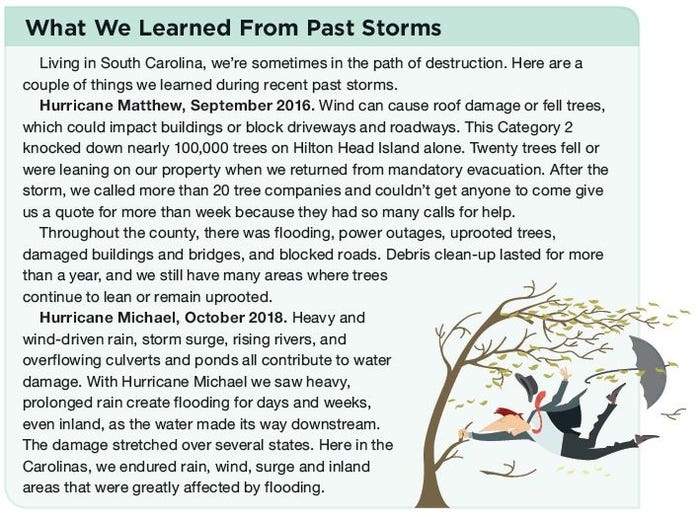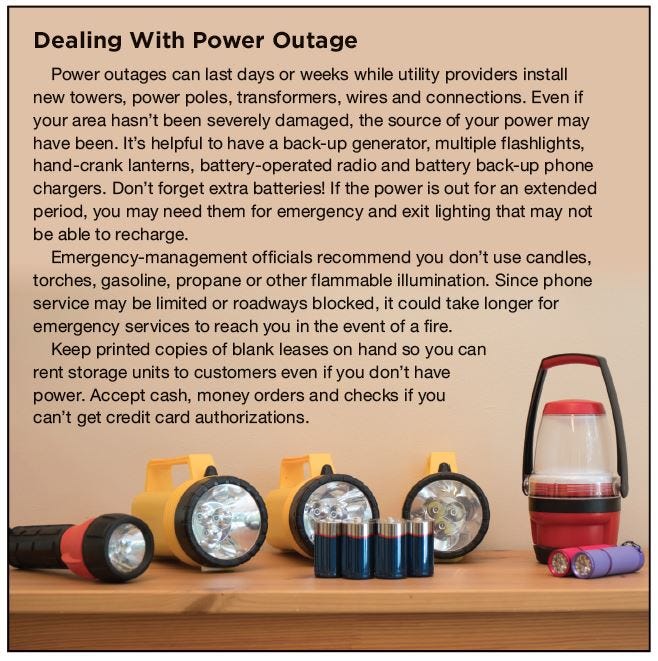Prepping Your Self-Storage Business for Hurricane Season
With hurricane season approaching, it’s time to prep your self-storage property. Having faced the wrath of past storms, the authors share how to protect your facility and communicate with tenants and the community.
The Atlantic hurricane season is June 1 through Nov. 30. This time can bring some of the most destructive weather to the United States and surrounding areas. It can also create great anxiety for self-storage operators and their customers. Hurricanes bring the threat of high winds, storm surge, flooding, power outages and damage that can range from minimal to catastrophic.
Preparation for a severe weather event should take place well before a watch or warning is issued. Don’t wait until the last minute! You and your tenants will be stressed, and you don’t want to miss a key step. Some items can be done days, weeks or even months in advance.
Prep List
Buy supplies. Well in advance, purchase plastic sheeting, tarps, animal traps, mops, buckets, cleaning supplies, chainsaws, work gloves, safety equipment, barricades, flashlights and batteries. Store these items in the most secure location on the property. Don’t wait, as they’ll be in high demand and could be hard to find or sold out.
Create a list of helpful vendors. This should include your insurance agent, a water-extraction service, a tree service, electricians, plumbers, contractors, gate companies, etc. Consolidate all their contact information in a single sheet or book you can take with you if you must evacuate.
Offer tenant insurance. Promote your tenant-insurance or tenant-protection program well before hurricane season begins. Most companies won’t issue policies once a watch or warning has been issued for your area. Encourage customers to add insurance to supplement their homeowner’s or renter’s policies.
Secure loose items. Signs, trash cans, benches, flags, banners, flower pots or other items that could take flight in high winds should be moved to a safe location well before the storm.
Prep the office. Elevate computers off the floor to protect against flooding. Secure all files and cash. Cover everything in plastic sheeting. Board windows or install hurricane shutters where possible.
Plan property access. Know how to lock down your gate and other facility access. Notify customers multiple times daily if you plan to close the facility, and consider your plan to allow access when you return. Commercial customers such as landscapers, contractors, tree companies, electricians, etc., may need access during the evacuation or immediately afterward, so communicate with them regularly. Make sure they know they may not have unit access until the property has been deemed safe by management. Encourage them to store necessary items at their home during the storm.
Plan for utilities. Know where your water and power shut-offs are and make sure they’re functional. Contact your utility providers and find out if they’ll cut power or if you need to shut off utilities prior to evacuation.
Stock up. Create a stockpile of bottled water, shelf-stable food, a manual can-opener, a change of clothes, cleaning supplies, etc. Since you don’t know if your home or workplace could be damaged, keep storm supplies at both locations. If you don’t need them, donate them to local charities to help others.

The Importance of Communication
Communication with customers is key. You want everyone to understand the steps you’re taking before the storm and the procedures for reopening. Load a tablet or laptop with the company management software so you can access e-mail addresses and other contact information while evacuated; or you can designate a person at your corporate office to handle communication.
It’s important you obtain storm information only from official sources. We learned during Hurricane Matthew that while some residents were reporting little or no damage in their areas, other parts of our community were severely damaged.
You can share information with customers through e-mail, your website, Facebook and other social media so they can get property updates, condition reports, your reopening schedule and other vital facts. If there was no damage at your facility, take and share photos. This will put your customers at ease. You can also post on local media sources to communicate with the community at large.
Give people ways to reach you via social media, e-mail, text, etc. Set up a live chat if possible. These channels of communication must be clearly shared with customers before an event threatens the area. During the stress of an evacuation, tenants won’t want to look up your contact information. Encourage them to put a link on their phone or save your e-mail or emergency phone number in their phones.
Once the storm has passed and the facility is deemed safe, send a general e-mail to all customers about its condition, the reopening date and other pertinent information. If some units were damaged, call or send specific instructions to those customers. Schedule a time for them to examine their unit, but limit access so you can control when and how long each person is on site. Again, this can only occur after the facility has been cleared by authorities.
If some but not all buildings are damaged, block off those areas. Those customers should get priority to move their items to other units once they deal with their insurance claims. Set aside new units in advance, preferably close to the tenants’ existing spaces. Match their current rate so they don’t incur a rent increase on top of having a damaged unit.

One Step Further
It’s likely that many of your customers and neighbors stocked up on supplies before the storm. If they didn’t need them, offer your facility as a donation drop-off for those in need. Coordinate with media to promote the effort.
Include a company donation to help increase efficacy. Some great items to contribute include bottled water, shelf-stable food, diapers, baby formula, towels, cleaning supplies, new shoes and clean clothes. Take photos and post them on your social media pages to encourage others to help. Once donations are collected, use your moving truck or other transportation to deliver items where they’re needed.
When it comes to hurricanes, prepare for the worst and pray for the best. Expect long days, sleepless nights, exhaustion, a lot of stress and unexpected problems. If you can handle this situation well, your tenants will appreciate your efforts. As word gets around, it’ll help build your facility’s reputation and improve your site performance.
Donna L. and Kevin J. Edwards are the property managers of Plantation Storage and Plantation Wine Cellars in Bluffton, S.C., which is operated by Southeast Management Co. Donna joined the company in 2016, while her husband was hired three years later. For more information, call 843.815.8000; e-mail [email protected]; visit www.southeastmanagementcompany.com.
About the Author(s)
You May Also Like





